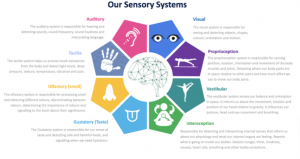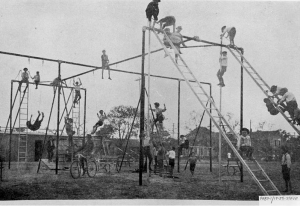
Why is SWINGING the BEST sensory game for your child?
First of all, we have to clarify WHAT the sensory system really is.
It is important to recognize that there are in fact 7 senses that make up the sensory system and it is these sensory systems that process information as the building blocks to many other skills.
The sensory system is composed of:
- The visual Sense is the ability to understand and interpret what is seen. The visual system uses the eyes to receive information about the contrast of light and dark, color and movement. It detects visual input from the environment through light waves stimulating the retina.
- Auditory Sense is the ability to interpret information that is heard. The auditory system uses the outer and middle ear to receive noise and sound information. They receive information about volume, pitch, and rhythm. It is important for the refinement of sounds into meaningful syllables and words.
- Gustatory Sense is the ability to interpret information regarding taste in the mouth. It uses the tongue to receive taste sensations and detects the chemical makeup through the tongue to determine if the sensation is safe or harmful.
- Olfactory Sense is the ability to interpret smells. It uses the nose to receive information about the chemical makeup of particles in the air to determine if the smell is safe or harmful.
- The tactile sense is the ability to interpret information coming into the body by the skin. It uses receptors in the skin to receive touch sensations like pressure, vibration, movement, temperature, and pain. It is the first sense to develop (in the womb), and as such is very important for the overall neural organization.
- Proprioceptive Sense is the ability to interpret where your body parts are in relation to each other. It uses information from nerves and sheaths on the muscles and bones to inform about the position and movement of the body through muscles contracting, stretching, bending, straightening, pulling, and compressing.
- The vestibular sense is the ability to interpret information relating to movement and balance. The vestibular system uses the semi-circular canals in the inner ear to receive information about movement, change of direction, change of head position, and gravitational pull. It receives information about how fast or slow we are moving, balance, movement from the neck, eyes, and body, body position, and orientation in space.

PICTURE: Sensory System
Sensory integration/processing is important because a newborn is able to see, hear and sense their body, but is unable to organize these senses well; therefore this information means very little. They are unable to judge distances or feel the shape of one object versus another. As the child is exposed to various sensory inputs, they gradually learn to organize them within their brain and are able to give meaning to them. They become better able to focus on one sensation and as a result, performance improves. Their movement changes from being jerky and clumsy, to more refined, and they are able to manage multiple amounts of sensory input at one time. By organizing sensations the child is able to modulate their response and as a result, they seem to be more connected with the world and in control of their emotions.
HISTORY of swinging
Swinging has been around in some form or fashion since man’s earliest moments. Homo erectus and then Homo sapiens were among the first to experience swinging pleasure on jungle vines. Though we really don’t have factual evidence of the unveiling of the first modern-day swing, a pendulum-type device suspended from a horizontal beam, we do find illustrative evidence in Europe and Asia of people swinging several centuries ago. You may recall from Western Civilization course studies, photos of well-dressed children playing on swings with flat board seats in the beautifully manicured Victorian gardens of the 1800s.

PICTURE: The Swing (1850) by Frederick Goodall. Engraved by E. Goodall. Oil on canvas. Exhibited at the Royal Academy in 1845.
During the Industrial Revolution and the advent of child labor laws, children needed public places to gather and play. With the development of the public park, the swing became one of the newly formed play environments’ most popular devices.

PICTURE: Playground in Industrial Revolution
It is important to note that public playground swings are no longer attached to composite play structures. Injury data from the ’70s and ’80s revealed that having a separate area for swings would help prevent injury from players running into swingers on the playground. In addition, large and heavy metal animal swings introduced during the post-World War II period have been eliminated from North American playgrounds to prevent injury from impact and create safer playgrounds.
So WHY is swinging such a BIG deal in child development?
Swinging allows a child to develop coordinated movements. It is almost impossible to teach a child how to swing. Through lots of practice and the motion of moving back and forth, they are successful in learning how to make a swing move.
Swinging is one of the best activities for young children to develop their sensory system. When a child swings, they are developing their ability to adapt to different sensations. The classroom is unusually loud, the lunchroom is overly chaotic, the cleaning crew used a new cleaning product or the clock is ticking loudly. All of these can affect a child’s ability to learn. If their sensory system is underdeveloped, it can be difficult for them to focus, keep their hands to themselves or walk down the hall to the lunchroom.
There are also other benefits of swinging, such as:
- It can be soothing as well as fun.
- It can feel calming to a child or a stressed adult.
- It can encourage social interaction and development.
- Swinging increases spatial awareness.
- Swinging helps develop gross motor skills—pumping legs, running, jumping.
- Swinging helps develop fine motor skills—grip strength, hand, arm, and finger coordination.
- Swinging develops a child’s core muscles and helps with the development of balance.
- Spinning on a swing stimulates different parts of a child’s brain simultaneously. This is important for learning skills such as spatial awareness, rhythm and balance, and muscle control.
With this gathered information it is not hard to conclude that SWINGING is the best outdoor and also indoor activity for the child’s sensory development. And it is not expensive at all!
Just take your child to the nearest playground with swings or if you have your own backyard mount a swing on a sturdy branch and see the joy on your child’s face =)
Or even better, on a rainy day- install a swing in your home and just #SWINGAWAY=)
Source: Sensory Processing – https://childdevelopment.com.au/areas-of-concern/sensory-processing/
Source: So, what’s the big deal about swinging – https://www.playgroundprofessionals.com/playground/swing-sets/so-whats-big-deal-about-swinging
Picture source: https://www.tcd.ie/disability/services/sensory-support.php
Picture Source: https://victorianweb.org/painting/goodall/paintings/6.html
Picture Source: https://playgrounddirectory.com/commercial/playground-equipment/a-history-of-playgrounds-playground-equipment/
Author: Maja Šobar, Sims-Tools
